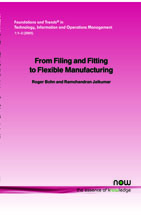From Filing and Fitting to Flexible Manufacturing: A Study in the Evolution of Process Control
By Ramchandran Jaikumar,
Abstract
A well-known but previously unpublished monograph by Ramchandran Jaikumar (1945–1998) on the nature and history of manufacturing. The development of mass manufacturing ranks as one of the most important contributions to human living conditions ever – of the same magnitude as agriculture and modern medicine. This monograph examines the development of manufacturing over several centuries, through the eyes of a single industry and company. Throughout this period, the key has been precise control of manufacturing processes, rather than production speed per se. There have been six revolutionary transformations in manufacturing, each involving a shift in hard technology, the nature of human work, and the nature of process control. Each epochal change was a step in the evolution of manufacturing from art to science. Each required a different ethos of process control and forced a new system of manufacture. Machines, the nature of work, and the nature of the organization all had to change in concert.
From Filing and Fitting to Flexible Manufacturing
From Filing to Fitting in Flexible Manufacturing is based on a well-known but previously unpublished monograph by Ramchandran Jaikumar on the nature and history of manufacturing. The development of mass manufacturing ranks as one of the most important contributors to human living conditions ever - of the same magnitude as agriculture and modern medicine. This monograph examines the development of manufacturing over several centuries, through the eyes of a single industry and company. Throughout this period, the key has been precise control of manufacturing processes, rather than production speed per se. There have been six revolutionary transformations in manufacturing, each involving a shift in hard technology, the nature of human work, and the nature of process control. Each epochal change was a step in the evolution of manufacturing from art to science. Each required a different ethos of process control and forced a new system of manufacture. Machines, the nature of work, and the nature of the organization all had to change in concert. A companion paper by Roger Bohn expands the concept of transition from art to science to encompass two more-or-less parallel shifts: in the nature of procedures, and in the level of technological knowledge. The level of knowledge can be modeled as a directed graph that maps current understanding of causality in the manufacturing process. As a process moves from art towards science, knowledge and its causal graph become more elaborate: new nodes are added, new relationships are established among new and existing nodes, and wholly new issues emerge and are gradually integrated with existing knowledge.

Companion
From Art to Science in Manufacturing: The Evolution of Technological Knowledge , Foundations and Trends® in Technology, Information and Operations Management, Volume 1, Issue 2 10.1561/0200000002